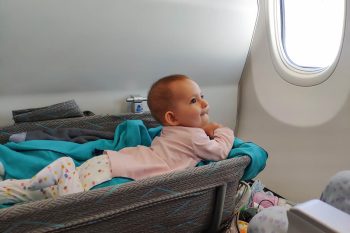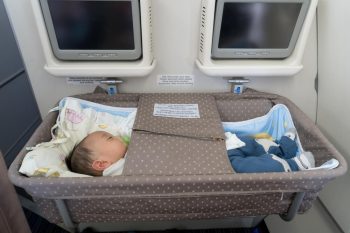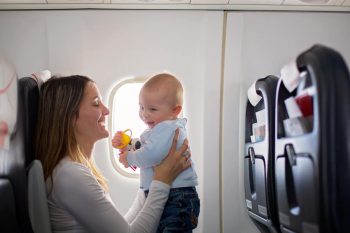Traveling with a little one can be both exciting and challenging, especially when it comes to air travel.
For parents, ensuring the safety and comfort of their baby during a flight is a top priority. What is the airplane bassinet weight limit: this is one essential consideration for many parents.
In this comprehensive guide, we’ll delve into everything parents need to know about airplane bassinet weight limits, providing valuable insights and tips to make your journey a smooth and enjoyable one.
Understanding Airplane Bassinet Weight Limits
What is an Airplane Bassinet?
An airplane bassinet, also known as an airplane cot, is a small sleeping area designed for infants on board long flights.
It attaches to the bulkhead wall in front of certain seats, offering a cozy space for your baby to sleep, rest, or play during the flight.

Importance of Airplane Bassinet Weight Limits
Airplane bassinet weight limits are crucial for ensuring the safety of your baby. These limits are set by airlines to prevent the bassinet from becoming unstable or posing a risk to the infant.
By adhering to these weight restrictions, you can rest assured that your baby will have a safe and comfortable journey.
Typical Airplane Bassinet Weight Limits
The specific weight limits for airplane bassinets can vary from one airline to another. On average, most airlines set a weight limit of around 20 to 22 pounds (approximately 9 to 10 kilograms).
However, it’s essential to check with your chosen airline before your flight, as these limits can differ.
Factors Influencing Airplane Bassinet Weight Limits
Aircraft Type
Different aircraft models have varying bassinet weight limits due to the configuration of the bulkhead area and the size of the bassinet.
Bassinet Design
The design and structure of the bassinet itself play a role in determining the weight it can safely support.
Safety Regulations
Airline safety regulations and guidelines also impact the weight limits to ensure the well-being of the infant.

Tips for Traveling with a Baby Within the Bassinet Weight Limit
Check with the Airline
Before booking your flight, contact the airline to confirm the exact bassinet weight limit for your specific journey.
Pack Light
To ensure your baby stays within the weight limit, pack only the essentials in your carry-on bag.

Weigh Your Baby
Before your trip, weigh your baby to ensure they fall within the airline’s bassinet weight limit.
Choose the Right Seats
Opt for seats that are designated for bassinet use. These are usually located near the bulkhead area.
Distribute Weight Carefully
If you have additional items in the bassinet area, make sure they don’t exceed the weight limit either.
Alternatives When Your Baby Exceeds the Weight Limit
Lap Infant
If your baby surpasses the bassinet weight limit, they can travel as a lap infant. However, keep in mind that this might be less comfortable for both you and your baby during the flight.

Child Restraint System
Some airlines provide child restraint systems, such as infant seats or harnesses, which can be attached to your seat. These are suitable for babies who have outgrown the bassinet weight limit.
As a parent, ensuring a safe and comfortable flight experience for your baby is of utmost importance.
Familiarizing yourself with the airplane bassinet weight limit, understanding the factors that influence it, and following the provided tips will help you make informed decisions and enjoy a stress-free journey.
Remember to check with your airline, pack wisely, and prioritize your baby’s well-being to create beautiful memories while traveling.
Disclaimer: The information provided in this article is for informational purposes only. Always verify the specific weight limits and guidelines with your chosen airline before your flight.



